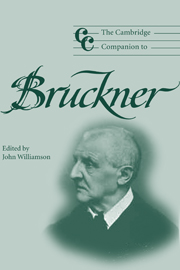Book contents
- Frontmatter
- Part I Background
- Part II Choral music
- Part III The symphonist
- 7 The Brucknerian symphony: an overview
- 8 Bruckner's symphonies – a reinterpretation: the dialectic of darkness and light
- 9 Programme symphony and absolute music
- 10 Bruckner editions: the revolution revisited
- 11 Bruckner and the symphony orchestra
- 12 Between formlessness and formality: aspects of Bruckner's approach to symphonic form
- 13 Formal process as spiritual progress: the symphonic slow movements
- 14 Bruckner and harmony
- Part IV Reception
- Notes
- Select bibliography
- Index
9 - Programme symphony and absolute music
from Part III - The symphonist
Published online by Cambridge University Press: 28 September 2011
- Frontmatter
- Part I Background
- Part II Choral music
- Part III The symphonist
- 7 The Brucknerian symphony: an overview
- 8 Bruckner's symphonies – a reinterpretation: the dialectic of darkness and light
- 9 Programme symphony and absolute music
- 10 Bruckner editions: the revolution revisited
- 11 Bruckner and the symphony orchestra
- 12 Between formlessness and formality: aspects of Bruckner's approach to symphonic form
- 13 Formal process as spiritual progress: the symphonic slow movements
- 14 Bruckner and harmony
- Part IV Reception
- Notes
- Select bibliography
- Index
Summary
The quarter century in which Bruckner composed his first symphonies contained no shortage of symphonies in general, and they exhibit considerable diversity of genre and style but they have largely not survived in the concert hall: although there remain many good reasons for claiming the symphony as the central genre of instrumental music in the nineteenth century, the years 1850–75 constitute a period richer in historical themes than in major works. Of 507 symphonic works considered in a recent survey, some have survived though overshadowed by their composer's later output (e.g. the first five symphonies of Dvořák). Others have lived on as rare examples of the genre from composers whose career flourished in other fields (e.g. Smetana's ‘Triumphal’ Symphony). Symphonists who have been rediscovered in the age of recording include the underrated Gernsheim, while Gade and Raff serve as examples of prolific composers who have clung on tenuously to experience intermittent modest revivals. The vast majority belong in the category of ‘forgotten symphonies’ discussed in another recently published thesis on ‘epigonality’ in the symphony.
The influence of Liszt seems reflected in the large number of programmatic works: symphonies, symphonic poems, and a host of intermediate genres such as the symphonic fantasy and overture-symphony. Closer inspection, however, discourages viewing the programmatic phenomenon uniformly as a monument to the triumph of the New German School. Among composers with a biographical link to Weimar is Raff, who composed programme symphonies that show little formal or procedural resemblance to Liszt; Draeseke serves as an example of a composer of symphonic poems who later turned to older concepts of the ‘characteristic’ symphony with few claims to the rhetoric of the ‘poetic’ espoused by Liszt.
- Type
- Chapter
- Information
- The Cambridge Companion to Bruckner , pp. 108 - 120Publisher: Cambridge University PressPrint publication year: 2004
- 1
- Cited by



